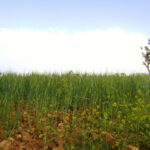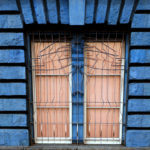
The sound and spirit of Zimbabwe and Mozambique runs through the heart of Timbila and Chartwell Dutiro’s double album collection Sadza with the Head of a Mouse. Timbila is a New York-based band, led by Nora Balaban, that met in Zimbabwe in 1997. Since then they have delved into the rich heritage of southern Africa’s songs and instruments, adding their own East Village multicultural explorations to the music. Here they are joined by vocalist and mbira master Chartwell Dutiro, a former member of Thomas Mapfumo and the Blacks Unlimited who now resides in the U.K.
The project is split into two distinct parts. Sadza features Dutiro leading the group through their unique interpretations of traditional Zimbabwean classics. Mouse is produced by Dutiro and is made up of Timbila’s original compositions and arrangements. The appreciation for the melodies, harmonies and rhythms of Zimbabwe and Mozambique link the two halves together as Sadza with the Head of a Mouse.
Driving the group’s sound is the timbila xylophone of Mozambique and the mbira lamellophone of Zimbabwe. Joined by guitar, bass, violin, drums and percussion, the timbila and mbira lead the ensemble and weave an intricate foundation for the musicians to improvise over. Balaban plays the mbira and timbila and is the lead vocalist of Timbila. Her broad vocal arrangements, with backing from the voices of Louisa Bradshaw and violinist Rima Fand, are a key component of Timbila’s approach. Guitarist and Afropop Worldwide senior producer Banning Eyre’s contributions are dynamic throughout this project, adding a distinct ambiance to each composition.
This vibrant combination can be heard immediately on “Chakwi,” the opening track of Sadza. The steady, resonant sound of the timbila and the supportive plucked phrases of the mbira work with the bass and violin to establish a trancelike repetitive rhythm that glides under Dutiro’s passionate vocals. Eyre floats complementary melodic harmonies across the mix on his guitar while Fand’s violin joins warm backing vocals to add depth to a song about dealing with the hardships of colonialism.
“Bukatiende” is a piece about the suffering experienced during the Zimbabwean liberation struggle and the missing loved ones who have been lost. Dutiro wears his heart on his sleeve with his enthusiastic, pleading vocals. With tender accents from Fand’s violin and a more setback role for Eyre’s slow, chiming phrases, the song captures the balanced, layered sound this ensemble puts together so well. The a capella ending is a striking conclusion to this standout composition.
Acoustic and overdriven electric guitar combine well on “Taireva,” a track about a disregarded warning that has troubling consequences. “Chikende” is an uptempo, joyous song that requires eating sadza (the staple dish of Zimbabwe) with the head of a mouse (a Shona specialty) before dancing. The ecstatic, harmonized violin and group vocals give great substance to the composition.
“Chinyan’anya” creeps along in a contemplative way with a busy bassline courtesy of Dirck Westervelt. The looping guitar and violin phrases playfully harmonize underneath Dutiro’s vocals in a number describing a ritual ceremony to call the ancestors. “Baya Wa Baya” is an ancient war song that builds slowly, sliding beautiful melodies and arpeggios into a fascinating arrangement.
Sadza concludes with “Nyuchi” which brilliantly throws tabla into the mix, changing the subtleties of the rhythm. This structured track shines with supportive group vocals and the crying out of Dutiro’s lead on a piece about the contradiction of life, with all its bitterness and sweetness, as well as a call for protectors.
Mouse sparks into life with “Walking the Pink Fire,” a driving original composition that cranks up the distortion on the timbila and puts the violin at the forefront. The combined resonance from the timbila and the violin is compelling, especially when accented by some nice lead guitar and a spacey drum solo by Bill Ruyle.
“My Heart Is a Real Thing” is a tender ballad based on the traditional song “Shanje.” Balaban handles all of the vocals in a lush vocal arrangement. The pace picks up for the catchy “Bones,” a twist on the traditional piece “Nyama Musango.” The playful guitar and violin duel builds to a climax as the musicians encourage one another to up the ante.
A gentle acoustic guitar opens “Toita Seiko,” a tune based on the traditional composition “Kariga Mombe.” The rustle of the resonant timbila shuffles with the percussion under a fine vocal arrangement which transitions well to the punchy “I’m Gone,” which has an exotic dub bridge that comes as a welcome surprise.
“Kiss Kiss Abyss” opens slowly before kicking up a gear in a great reimagining of the traditional “Mukatiende,” with the band firing on all cylinders. “Kachoo,” based on a Chopi timbila piece, is instantly catchy with the timbila and violin singing in unison.
The Mouse disc comes to a close with the reflective and soothing “Winter to Spring,” based on the traditional “Karinga Hore.” The song feels like a turning of seasons and wraps up this collection in a graceful way as Dutiro’s aching vocals join the ensemble towards the end of the track.
Across two different albums, Timbila and Chartwell Dutiro bring a particular style to these arrangements. The combination of the timbila and mbira, supported by violin and guitar, gives an immense amount of texture to the music. Added to the layered vocal arrangements and the irresistible rhythm of each track, Sadza with the Head of a Mouse delivers a gripping listening experience from start to finish.
Originally published in RootsWorld Magazine.




Be First to Comment